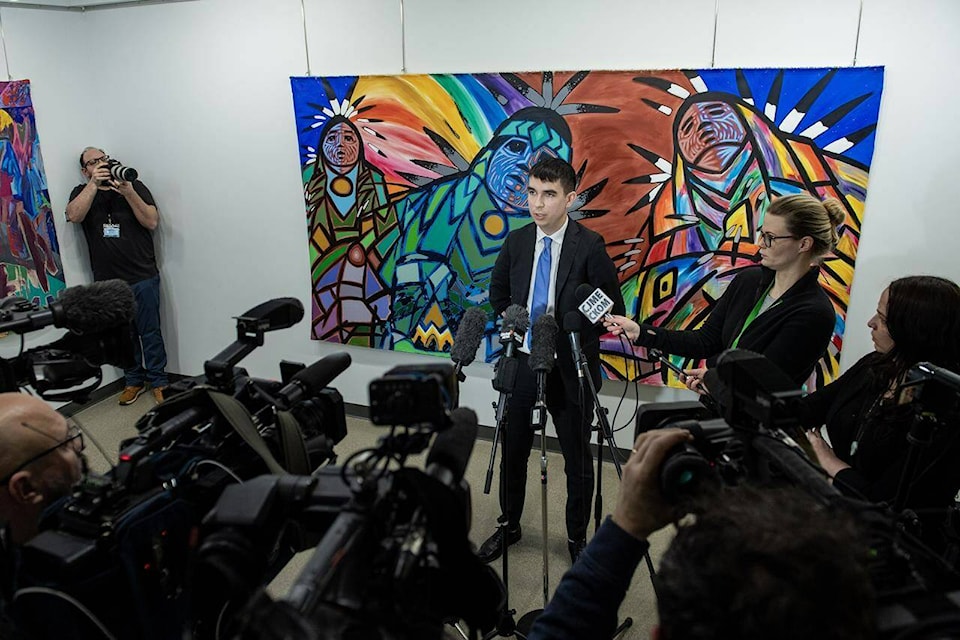Myles Sanderson and his brother were driving around a Saskatchewan First Nation causing havoc, assaulting people and selling drugs in the days and hours before a mass killing in the community.
The first day of a coroner’s inquest into the stabbing rampage saw text messages that Damien Sanderson sent his wife, Skye Sanderson, as the brothers caused chaos in the community.
“I’m done ready to die,” Damien Sanderson said in one message on the afternoon before the attacks.
RCMP have said Damien Sanderson was the first to be killed by his brother.
Myles Sanderson then went on to kill 10 more people and injure 17 others on James Smith Cree Nation and in the nearby village of Weldon on Sept. 4, 2022. He later died in police custody.
The inquest, which is being held in Melfort, northeast of Saskatoon, heard evidence from Staff Sgt. Robin Zentner on Monday. The Mountie described how Damien Sanderson’s texts became fatalistic as he spent more time with his brother.
Zentner, who is with the RCMP’s major crimes unit, prepared a 188-page presentation laying out the investigation into the killings, including information about Sanderson’s record and the police response to the attacks.
The inquest heard Myles Sanderson went to the First Nation with the mother of his children to sell drugs a few days earlier. At one point, the couple began to argue and Myles Sanderson attacked her in front of his brother’s house.
Damien Sanderson attempted to calm Myles Sanderson down, the inquest heard, and the brothers drove off together in Skye Sanderson’s vehicle.
The inquest heard the brothers spent the following days having run-ins with people on the community. In a 911 call played for the inquest, Skye Sanderson called Mounties to report that her husband had taken her vehicle without permission. She never mentioned Myles Sanderson.
Zentner said RCMP located the vehicle at a home on the First Nation but officers only had a photo of Damien Sanderson from 2014. They didn’t recognize Damien Sanderson in the home, Zentner said, and he gave police a false name.
Skye Sanderson had also texted Damien Sanderson, urging him to come home and sleep.
“I’m down to die, me and my brother,” Damien Sanderson responded.
Zentner said Damien Sanderson’s responses to his wife, mentioning death multiple times, didn’t seem to match being in trouble for a stolen vehicle.
The officer said nobody has ever provided context to RCMP, but investigators suspect something more was going on.
RCMP have said because Myles Sanderson is dead, people may never get all the answers about what happened.
The inquest is to establish the events leading up to the killings, who died, and when and where each person was killed. It is expected to last at least two weeks.
“The objective is to have the story told, honour those victims that died on that day and try to come up with some recommendations that will help prevent this from happening again in the future,” said Clive Weighill, Saskatchewan’s chief coroner.
The six-person jury was selected Monday morning. Two others, who will attend the inquest and listen to the evidence, were chosen as alternates.
Keith Brown, the lawyer representing the First Nation in the inquests, said three jurors are visibly Indigenous.
“The coroner did a really good job of what looks like a representative jury in terms of Indigenous voices (and) non-Indigenous voices of the region,” Brown said.
A second inquest focusing on Sanderson’s death is scheduled for February. Public inquests are mandatory in Saskatchewan when a person dies in police custody.
Without a trial, Weighill said, the inquest is the only way the family and public can hear exactly what happened.
Family members of the victims gathered together to smudge, a traditional practice for safety, well-being and healing, throughout the first day of the inquest.
Chief Robert Head of Peter Chapman First Nation, one of three bands that make up James Smith Cree Nation, said many were apprehensive about the inquest reopening wounds and causing trauma. But they feel reassured.
“It was conducted in a very respectful way today, and I was very happy with that,” Head said.
The Federation of Sovereign Indigenous Nations, which represents 74 First Nations in Saskatchewan, extended sympathies.
“We wish all those affected may find some consolation and strength during this unprecedented time of immense sadness and grief,” Chief Bobby Cameron said in a news release.
First Nations leadership has said they hope the inquest will provide recommendations about self-administered policing. They also would like to see First Nations receive a notification when a member is released from prison.
Sanderson, who had a record of violent assaults, received statutory release earlier in 2022 but was unlawfully at large at the time of the killings.
“What we’d like to hear from the parole board is why he was released so easily,” Head said.
READ ALSO:
READ ALSO:



